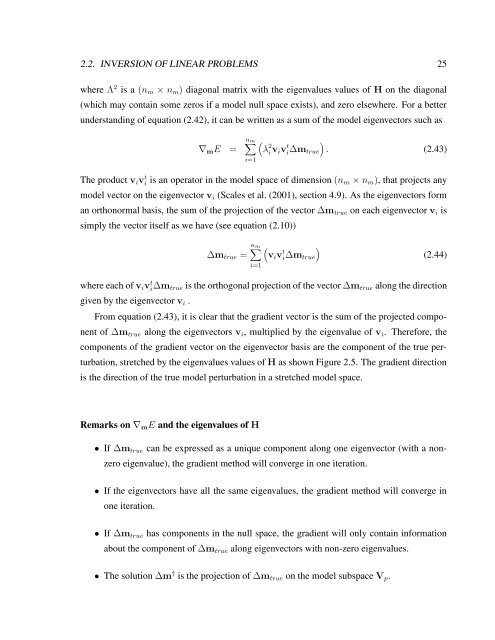Sirgue, Laurent, 2003. Inversion de la forme d'onde dans le ...
Sirgue, Laurent, 2003. Inversion de la forme d'onde dans le ...
Sirgue, Laurent, 2003. Inversion de la forme d'onde dans le ...
You also want an ePaper? Increase the reach of your titles
YUMPU automatically turns print PDFs into web optimized ePapers that Google loves.
2.2. INVERSION OF LINEAR PROBLEMS 25<br />
where Λ 2 is a (n m × n m ) diagonal matrix with the eigenvalues values of H on the diagonal<br />
(which may contain some zeros if a mo<strong>de</strong>l null space exists), and zero elsewhere. For a better<br />
un<strong>de</strong>rstanding of equation (2.42), it can be written as a sum of the mo<strong>de</strong>l eigenvectors such as<br />
∇ m E =<br />
n m ∑<br />
i=1<br />
(<br />
λ<br />
2<br />
i v i v t i ∆m true<br />
)<br />
. (2.43)<br />
The product v i vi t is an operator in the mo<strong>de</strong>l space of dimension (n m × n m ), that projects any<br />
mo<strong>de</strong>l vector on the eigenvector v i (Sca<strong>le</strong>s et al. (2001), section 4.9). As the eigenvectors form<br />
an orthonormal basis, the sum of the projection of the vector ∆m true on each eigenvector v i is<br />
simply the vector itself as we have (see equation (2.10))<br />
∆m true =<br />
n m ∑<br />
i=1<br />
(<br />
vi v t i∆m true<br />
)<br />
(2.44)<br />
where each of v i vi∆m t true is the orthogonal projection of the vector ∆m true along the direction<br />
given by the eigenvector v i .<br />
From equation (2.43), it is c<strong>le</strong>ar that the gradient vector is the sum of the projected component<br />
of ∆m true along the eigenvectors v i , multiplied by the eigenvalue of v i . Therefore, the<br />
components of the gradient vector on the eigenvector basis are the component of the true perturbation,<br />
stretched by the eigenvalues values of H as shown Figure 2.5. The gradient direction<br />
is the direction of the true mo<strong>de</strong>l perturbation in a stretched mo<strong>de</strong>l space.<br />
Remarks on ∇ m E and the eigenvalues of H<br />
• If ∆m true can be expressed as a unique component along one eigenvector (with a nonzero<br />
eigenvalue), the gradient method will converge in one iteration.<br />
• If the eigenvectors have all the same eigenvalues, the gradient method will converge in<br />
one iteration.<br />
• If ∆m true has components in the null space, the gradient will only contain information<br />
about the component of ∆m true along eigenvectors with non-zero eigenvalues.<br />
• The solution ∆m † is the projection of ∆m true on the mo<strong>de</strong>l subspace V p .

















